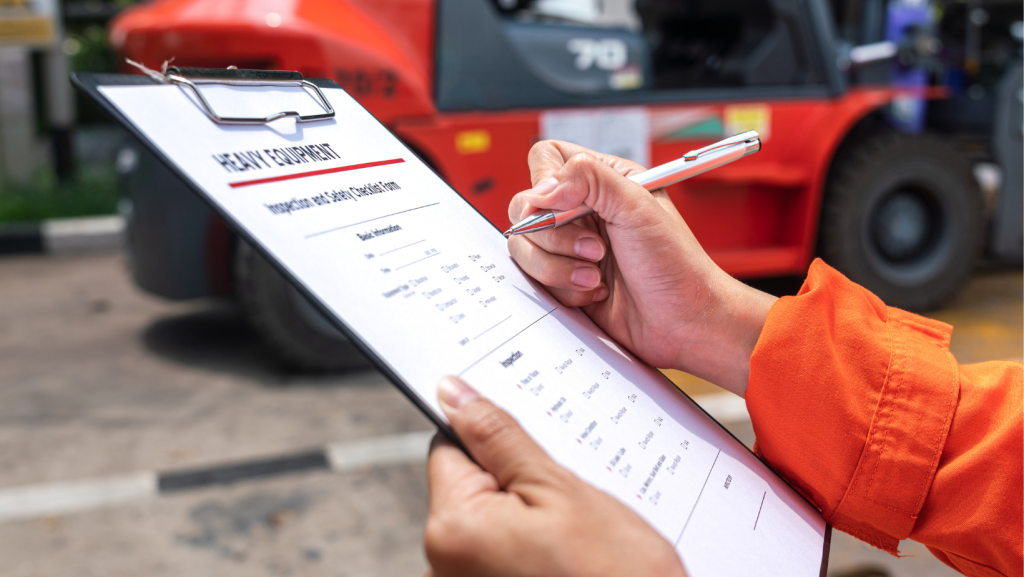The Ultimate Guide to Forklift Safety

Forklifts are an instrumental piece of machinery for your site. Operating a forklift demands precision and caution; safety protocols are, therefore, a top priority. In this comprehensive guide, we will explore essential safety measures and expert tips to equip novice and experienced forklift operators with the knowledge and skills they need to use a forklift safely. Whether you want to enhance your proficiency or establish a safer workplace, join us on this journey to prioritise forklift safety.
14-Step Guide to Forklift Safety
The Health and Safety Executive (HSE) declares that, on average, forklift trucks are involved in a quarter of all UK workplace vehicle accidents. A lot of these accidents are avoidable, so minimise forklift accidents by following our ultimate guide to forklift safety:
- Forklift Training
- First and foremost, forklift operators should be fully trained and qualified before driving a forklift. Although there is no such thing as a forklift license, operators must have been awarded a certificate for completing a forklift training course to be allowed by most employers to use a forklift. Forklift training is essential to ensure a forklift’s safe but effective use in the workplace.
- Pre-Operational Examination
- At the start of your working day, you should take some time to carry out pre-operational safety checks on your forklift. If you discover any faults or maintenance issues with your forklift during the examination, you should cease using it and inform your supervisor as soon as possible.
- Weather Precautions
- Understanding how to use a forklift in unfavourable weather conditions is critical. Forklifts can be used in the rain; however, the operator must take extra care to keep themselves and others safe. When driving a forklift in the rain, operators should wear appropriate waterproof clothing to help prevent slips, limit distractions, and ensure enough visibility before operating the forklift.
- Load Capacity Considerations
- Ensure that you are aware of the loading capacity of your forklift. Taking shortcuts by overloading your forklift to make fewer trips is a significant safety hazard. When loading your forklift, load it carefully and evenly so that your view is not obstructed while driving and the weight is within its approved capacity to prevent tipping.
- Sensible Fork Height
- The general rule that forklift operators should follow is to always drive with their forks around 6 inches from the ground when travelling, specifically when carrying a load. This is to ensure that potential hazards on the ground are avoided and to provide stability whether or not there is a load on the forklift. Never raise or lower your forks while you are in motion.
- Drive at a Safe Speed
- When driving a forklift, always ensure you are driving slowly and steadily, especially when carrying heavy loads. It is not wise to drive a forklift over its speed limit; the general rule is that it should not be operated indoors at more than 10 kph. Drive at a speed that gives you complete control over the vehicle to keep yourself and others around you safe.
- Eliminate Fast Movements
- Avoid turning sharp corners or moving at speed; sudden movements can throw the forklift off balance. When you combine a sharp turn with an inappropriately loaded forklift, you are more likely to cause the forklift to tip over. Driving carefully is very important to ensure your safety.
- Never Leave an Operating Forklift Unattended
- Not only is it illegal in the UK to leave the keys in an unattended forklift, but it is a significant safety hazard as it risks the possibility of an unauthorised person operating the forklift and causing potential accidents or injuries.
- Wear your Seatbelt
- If your forklift is equipped with a seatbelt, then as HSE rules, “Where restraining systems are fitted, they should be used.” Wearing your seatbelt is a responsibility you should take seriously. Although not wearing one will not cause an accident, it can significantly minimise the consequences if an accident does occur.
- Check your Surroundings
- Keep in mind that there will be others on site or in the warehouse where you are operating a forklift. Always check your surroundings before you start operating the forklift. Don’t solely rely on your mirrors; look around and check your blind spot, especially before reversing.
- Ramp Safety
- Be cautious when you are operating a forklift on a ramp. Always drive in a forward direction up a ramp and down a ramp in reverse. This ensures that your load will not tip off the forklift as it tends to be top-heavy. Before you reverse down, ensure that your surroundings are clear and you have complete visibility to prevent accidents from occurring.
- Pallet Quality
- When loading your forklift, ensure you use high-quality pallets in good condition. Pallets should be evenly balanced; avoid using old or broken pallets, as this reduces the safety of the load. Use binding or rope to secure the pallets to the forklift for added security.
- Repairs and Maintenance
- Operators should carry out regular maintenance checks on a forklift. These checks will ensure that the forklift is in good working order and can be used safely by operators. Failure to do so can result in sudden breakdowns of the forklift, which can lead to injury of the operator and pedestrians and damage to both the forklift and its load.
- Refuel and Park
- When it is time to refuel, your forklift should only be refuelled at designated locations specifically for forklift refuelling. At the end of your shift, you should park the forklift in a safe and authorised space. Ensure the forks are fully lowered to the floor and the parking brake is on before removing the keys. Store the keys safely to prevent unauthorised personnel from retrieving them.
Forklift Operator FAQs
How often should forklift operators receive training?
Although there is no legal requirement, refresher training is recommended every 3-5 years to update your knowledge and refresh your forklift operating skills.
How many truck lengths should be kept between forklifts?
The ideal travelling distance between forklifts is approximately 3 truck lengths. If another vehicle or a pedestrian is within 3 truck lengths from the forklift, the operator must stop and wait for a safe distance before resuming operation.
What checks should I carry out on my forklift daily?
Firstly, operators should check fluid levels, such as oil and coolant. They should also ensure that their lights are working correctly and inspect whether their forks don’t have any cracks or bends in them. Carrying out these checks will maximise safety levels when operating a forklift.
Forklift Safety with HL Training
As a forklift operator, use our ultimate guide as your pocket handbook to ensure forklift safety. However, the above information only matters if you have received accredited forklift training. At HL Training, we can provide you and your team with the training courses necessary to operate a forklift safely and efficiently. Whether you are a novice or an experienced operator, our team can provide you with trusted training to boost your knowledge and skills when operating a forklift. We offer a range of training courses both in-centre and onsite across the UK. Contact our team; we are happy to help you find the right course.


